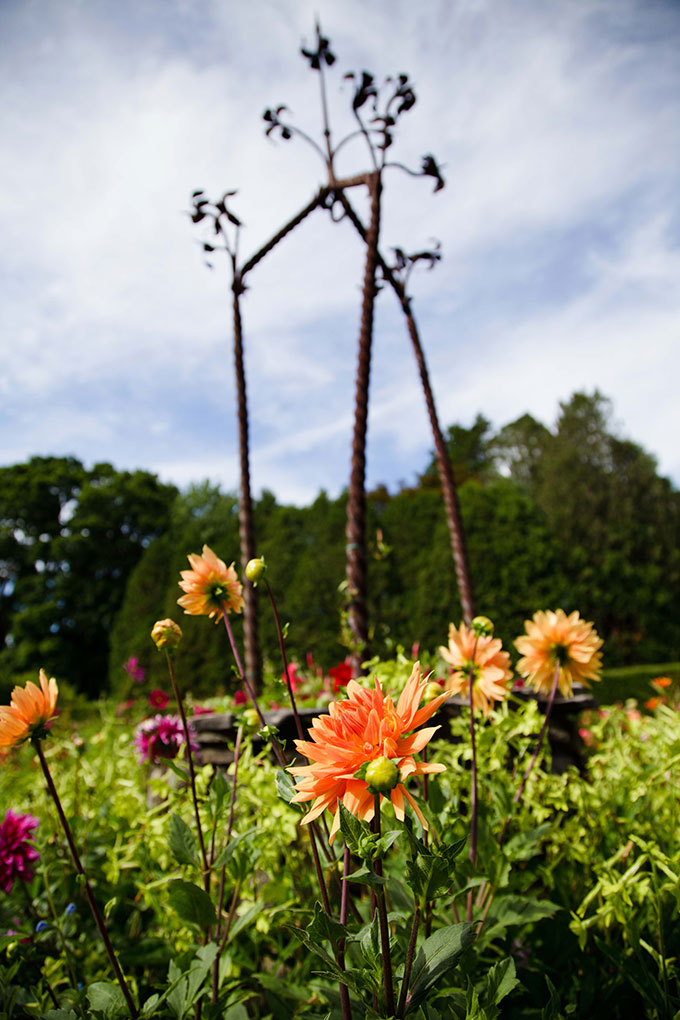 Most gardening problems can be avoided by following these simple guidelines
Most gardening problems can be avoided by following these simple guidelines
by Jamie Colen, Garden Director
The optimal amount of water as well as the most effective method for watering depends on the type of plant and the soil structure. Many types of full sun plants and vegetables prefer to dry out slightly between water applications – plants such as roses and annuals fall into this category. These plants bloom all summer and also have more intense nutrient needs than perennials that only bloom once during the season. A general rule to remember is that plants that prefer sunny locations are high energy, requiring more neutral pH, and richer soil. Plants that prefer more shady locations such as hosta and impatiens tend to like more acidic, less rich, evenly moist soil. Deep, regular water application promotes deep roots and makes plants more drought tolerant. Most often seen in turf situations, the frequent light water applications will promote shallow roots and encourages rot, fungus outbreaks and disease.
Grow the correct plant in the correct location! Grow the correct plant in the correct location! A mistake is assuming that because the light needs of a plant is met, all should be fine. While some plants that tolerate shade will wilt in too much heat, this certainly can be correctly explained by a lack of water, but frequent wilting can also be a symptom of the plant being in the wrong space. A begonia for instance, is a shade plant that prefers to dry out slightly between watering and can easily wilt and will eventually rot from being watered too often. Conversely, rose bushes and other high energy plants simply will not bloom if they do not have enough sun – a common misdiagnosis is to assume a lack of fertilizer, which will cause further problems., such as salt damage. Its bears repeating: A high energy/full sun plant prefers rich, even pH soil, and can dry slightly between being watered – and a plant that tolerates shade prefers its roots in slightly acidic, evenly moist soil. There are subtleties within the way plants grow that can indicate it is under stress, so it helps to understand the light, soil and nutrient needs of a plant before you choose a site.
Bark mulch can be attractive and harmless for acid loving, low energy plants such as evergreen hedges, azalea, rhododendron’s, and other foundation plantings – however, it should be applied with caution. It may look nice, but bark mulch will eventually change the chemistry of soil. If soil becomes too acidic, it is potentially detrimental for higher energy plants like rose bushes and annuals that require a pH closer to neutral and richer soil. Neutral pH is 7.0 and most ornamental plants will grow fine in a range of 6.4 – 6.9. As pH drops below 6.2 or so, nitrogen, the most important and mobile nutrient becomes unavailable to plants, especially higher energy plants. Yellow leaves and drab growth is the result – and this again is typically misdiagnosed by lack of fertilizer – no matter how much is applied, the problem will only become worse. Lime reverses low pH soil and slowly will release locked up nitrogen and subsequently other nutrients found in the soil. It is generally a good idea to get your New England garden on a program of lime application once a year. BUT, know the conditions in which your plant requires and test the pH of your soil once every two years and adjust if necessary. Many lawn care professionals and landscapers use bark mulch convinced it keeps weeds at bay, and it is piled deeper and deeper every season. This is especially hazardous for trees as the mulch end up covering the flare of the tree and will promote rot. The use of bark mulch in many instances also causes compaction which will in turn will not allow the soil absorb water efficiently. It also may contain unwanted insects, their eggs and fungus spores which can destroy the roots, foliage, and buds of perennials and annuals. To keep a weed free garden, add dehydrated cow manure once a year, (or another pH neutral compost) then simply cultivate your soil once a week with a four pronged long handle cultivator. Your soil will benefit greatly and you can cut your trips to the gym to only twice a week!
Pests are simply any animal that is unwanted or does damage to things we want to protect. Many ‘pests’ are food for beneficial insects, amphibians, and birds – these animals naturally control pest populations. Contrary to popular belief, the key to treating ANY pest problem is not to react too fast and kill them with pesticides. These chemicals will kill or harm both the pests as well as the beneficial insects and animals in your garden. Aphids for example are small green soft bodied insects that will gather atop developing rosebuds and other plants in order to extract sap. Prey insects like aphids will always outnumber beneficial predators such as the ladybeetle, that feed on aphids by about a ratio of 100:1 Most beneficial insect species such as lady beetles reproduce once or twice a year will be damaged by pesticides beyond their ability to recover as opposed to aphids that reproduce once every few days. Indiscriminate spaying of pesticides will knock out only half of the target pest (that build immunity to pesticides very quickly) and most if not all of the predators. Aphids usually cause very little damage to the health of a plant and can simply be sprayed off with water or they can be squeezed off with a gloved hand. The beneficial insect hero and predator is the ladybeetle, and they will devour hundred of aphids a day, so it is best to simply wait for them to do their job. There are many such examples going on in your garden, so be mindful before choosing any pest deterrent. The observation of the dynamics of nature is one of the most rewarding aspects of gardening!
April
Spring Care
- After the snow melts, begin by removing all loose winterizing material and/or downed leaves and branches from your lawn and plant beds. The use of an indicator plant such as when the crocus begin to bloom is a signal that the soil is warming up and that plants will begin to break dormancy.
- For lawns, use a stiff flexible metal rake that will help stand up the grass plants and aerate the surface. This will allow oxygen and water to get through to the roots and discourage matting and dead spots. Caution: Leaf blowers alone will move some material, but raking is THE way to begin a healthy lawn care program.
- In flower beds and perennial beds, clean carefully with a rake and remove all loose debris. Be mindful that rhododendrons and other evergreen plants prefer to have their roots covered with a layer of their own leaves, so leave some around the drip edge of those plants.
- Roses: remove the winter protection of soil around the crown and prune. Depending on how severe the winter was, there could be an abundance of healthy canes. Simply prune every cane back to where it is green. (or alive) Some canes are red and older ones have bark on them. The sure way to see if a cane is alive is to look for the green cambium layer after some test cuts. A general rule is to cut each cane to at least as thick or thicker that the diameter as a pencil. Don’t worry about ‘thinning out’ the bush and removing crossing canes just yet.
June and through the Summer:
Perennials & Annuals
- Begin perennial and annual maintenance: deadhead, weed, cultivate and water if necessary.
- Keep beds free of leaves and cultivate weekly.
- Watch carefully for plants that grown fast, they will need staking.
Roses
- Water weekly if necessary, do not saturate
- Apply dehydrated cow manure up to 1′ thick or organic compost, work into soil twice during the season.
- Watch for yellow or damaged leaves as remove as soon as they appear.
- Fertilize beds with a 100% organic fertilizer at the end of May and again in early July – cultivate into soil, and water. This is best to do before a soaking rain.
- Watch for weak or damaged canes and remove them. You may thin out smaller canes now if needed.
Trees & Shrubs
- First hedge pruning of Privet and Taxus (Yew). Privet hedges may need 3-4 more prunings throughout the season, Taxus should only need 1 per season.
- Do not apply mulch around trees up to and around the crown! This will cause rot and weaken and eventually kill the tree!
Fall/Winter care
Halt deadheading roses by the first of September! This allows the hips (which is the seed case) to develop, which will send a signal to the plant and slow new growth in order to maintain remaining canes through the winter. Tie the canes up together in October in order to prevent them from breaking during winter winds. When the soil freezes in early December, bring in and apply a pile of soil or compost to cover the crown of the rose bush up to two feet high. This will keep the rose bush from thawing and refreezing during the winter and protect it against pests like voles, rabbits and mice which will chew on the cambium layer of the canes. It is crucial to wait until the soil has begun to freeze, otherwise you will be inviting many of these animals to a free home! Winter PEST CONTROL: Spraying a product such as ‘Deer Away’ are ‘Deer Off’ will discourage these animals from browsing on your plants as well. This product is natural, made from eggs and cayenne pepper and does not harm plants! Once applied it will last for months and will deter herds of deer from visiting your property. To further control deer browsing, much success has been had by using prey scent around your property such as coyote urine. Animals use scent to communicate, so if deer sense that predators are nearby, they will change their habits and begin to move elsewhere.
Hours and Directions
We are open mid-May through mid-October
Daily, 10:00AM – 5:30pm
10 Willow Avenue
North Hampton, NH 03862
(603) 964-5414
Get Directions
Annual Mother’s Day Weekend Plant Sale 2024
Our classic plant sale! Held on Mothers Day weekend for all three days: Friday, Saturday and Sunday, May 10th, 11th and 12th, 2024 from 10am to 3pm! Featured for sale will be hundreds of field grown hardy perennials, potted hardy rose bushes of all varieties,...
July Garden Party 2024
Join us for the July Garden Party! Wednesday, July 10th, 2024 from 5:00–8:00pm. Limited to 150 tickets. Order now! Live Jazz by Greg Brown and Friends, beer tasting with Throwback Brewery, wine, light appetizers, local art sale and fun folk! Don't miss this one!
Reggae ‘n Roses Party 2024
Join us for a night in the garden! Good cheer, delicious food, and lively music by Stream Reggae band. Throwback Brewery will be providing refreshments. Friday, August 9th, 2024 from 4:00pm-7:00pm This is a 21-and-over event. Non-Member tickets are $50 per...
